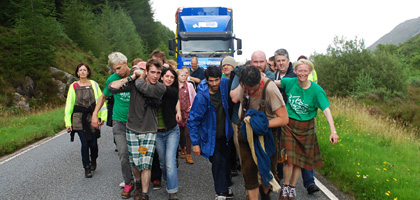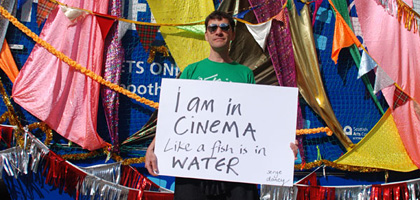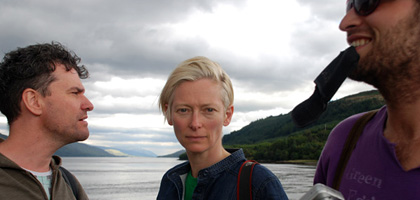News
Tug of love: a cinema pilgrimage

Nick James helps Tilda Swinton and Mark Cousins drag a cinema across the Highlands
During his great American journey of 1964 (famously described in Tom Wolfe's The Electric Kool-aid Acid Test) writer Ken Kesey told the 'Merry Pranksters' who kept wandering off at stops, “You're either on the bus or off the bus.” For 'fellow travellers' of Tilda Swinton and Mark Cousins' A Pilgrimage - a mobile cinema tour that zig-zagged through the highlands - the message was equally blunt: if you're on the bus, you're pulling the cinema.
The movie house in question is the Screen Machine, a trailer truck that unpacks to an 80-seater cinema roughly three times as large. Advance details were vague as to what 'pulling a cinema' might mean, but anyone who had attended last year's Ballerina Ballroom of Dreams (see S&S Oct 2008, p.11) could feel confident that the guiding forces would be an imaginative flair disguising quite careful planning. For motivation we could read Cousins' candid call to rope: “Why pull a 37-ton cinema across a nation? Because the nation [Scotland], and movies, are beautiful, and we want to express our love for them.” A fragile ideal, then: to marry real exertion and real landscape to a transcendent cinema.
The Pilgrimage core group greeted us at Bridge of Orchy train station, yelping and wildly waving placards that read 'Norman Maclaren', 'Preston Sturges', 'Lillian Gish'. It was raining as we were led down to the reassuring sight (for a Londoner like myself) of a shiny Routemaster bus. Then the first hitch was explained: the minibus meant to carry the luggage had broken down. Fortunately a camper van owner offered to take the bigger bags of 40-50 people.

Such automatic generosity is typical of the people these events attract. This year's all-ages, multi-national, many-purposed crew soon found itself hurtling through Glencoe under black clouds. Reality didn't bite until we passed a blue trailer truck festooned in ballroom drag - the Screen Machine itself. Soon high-visibility jackets were handed out to volunteer stewards and then, at a layby some miles short of Kinlocheven, we filed out into the rain and the midges: our enthusiasm for cinema, for screenings of Preston Sturges' Sullivan's Travels (1941) and Les Blank's Burden of Dreams (1982), was about to be tested.
A naval rope about three inches thick and long enough for us all was threaded through the truck's lugs. We took the rope up in two lines, with the principals at the front and, as cameras whirred around us, we began hauling. That the truck moved at all was mildly amazing. It took effort - though not too much gut-wrenching tug-of-war effort - and it was great fun. We pulled for more than a mile before getting back on the bus and heading into Kinlocheven, by repute the wettest place in Scotland.
So it proved and for some the first night was all about foraging and finding dry shelter. The campers got very wet; the Routemaster developed trouble with its brakes; the programmed music had been left at a distant B&B. Thus there was a tentative feel about the introductions to the first screenings, though the films soon put us all in a good mood and watching the travails of the Peruvian Indians dragging Werner Herzog's boat uphill in Blank's documentary soon put our paltry woes in perspective.
Next day, after a cheery screening of Iranian director Mohamed Ali-Talebi's children's classic Bag of Rice (1996) - a film choice typical of the Swinton-Cousins 8 1/2 Foundation, which aims to create a library of films to be offered to children when they are 8½ - many were secretly glad to see a gleaming new tourist bus arrive. Though it lacked the Routemaster's touch of romance, it gave great views and could handle everyone's luggage. Riding the Corran ferry across Loch Linnhe as the weather improved gave us our first chance to really drink in the landscape. Then the sun, too, decided to show up, so that when it was time to pull again up a gradient along a fabulous valley there was more alacrity and holiday spirit put into it - which was fortunate, since the distance seemed longer.

We arrived at the village of Strontian, whose ethereal setting was ideal for screening the wonderful nonsense that is Vincente Minnelli's Brigadoon (1954). As soon as the lights went down for the introductory song and we heard Roy Orbison sing that Lynch-invoking line “a candy-coloured clown they call the sandman”… we knew that the festival had found its groove. Thor Fridrik Fridrikson's Cold Fever (1995), too, had most of us enraptured, though Mark Cousins was mortified that the version projected was not the original one that changes format when its Japanese protagonist leaves Tokyo for Iceland.
Publicity from the first day was already beginning to have its effect with local visitors. One of the pleasing things about this event is the way that the travelling entourage seamlessly integrates with the casual drop-by crowd the event is really hoping for, though the sometimes raucous pre-film clapalongs to music take many by surprise: 'Where am I?', you see them thinking. 'Is this a tent-show gospel meeting or a school disco?' They soon usually relax into the celebratory mood, however, helped by sweets handed out by Tilda Swinton beforehand.
Properly bonded and rested after a morning screening of Satyajit Ray's The Adventures of Goopy and Bagha (1968) - which has an entrancingly weird ghost dance sequence - the fellow travellers bussed back to the ferry and on to the rather more touristic haven of Fort Augustus at the tip of Loch Ness. This was my final stop, though there were three more days on the road to go, and the profoundly emotional pairing that evening of Powell & Pressburger's A Canterbury Tale (which has strange affinities with Brigadoon) and Bresson's Au hazard Balthathar (which has some echoes of Henry Hathaway's Peter Ibbetson, shown at the ballroom last year) deepened the sense that I was leaving too soon. I would miss Culloden at Culloden and Throne of Blood at Cawdor, but if you're off the bus, you're off the bus.
